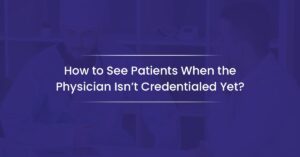Provider credentialing is used by healthcare practices to ensure that all employees, applicants, and associated providers have the necessary credentials to perform their obligations reliably.
As a result, the nonexistence of reliability and regularity can cause reliance to vanish with time. That reliance and expectation of patients increases by executing these credentialing practices.
Providers’ credentialing is significant for patient health and safety because it is the basis for instituting reliance among critical stakeholders in the healthcare sector. This article will outline how to credential a provider, the mandatory facts for credentialing a healthcare provider, and why reliance on expertise can be valuable in exploiting effectiveness.
The Provider’s request is forwarded to contracting, ensuring the finishing point of the credentialing level. At this point, the credentialing services may offer the provider and healthcare practice an “in-network” contract. If they are accessible to an agreement, it will usually include the payment plan and the CPT codes for which they are entitled to medical billing. We use the term “credentialing” to refer to both the credentialing and contracting periods of the credentialing process. Credentialing professionals are competent and qualified to peruse credentialing and contracting to certify that providers are on board. In this article, you will get an insight into how to credential a provider through medical provider credentialing services and take a brief overview of Provider credentialing.
What Exactly Does Provider Credentialing Entail?
Provider credentialing is a screening process used by medical practices and insurance companies to authenticate a provider’s background data, expertise, and proficiency levels. All providers pursuing healthcare privileges must clear the credentialing process. Conventionally, Provider credentialing has been a laborious and time-consuming, paper-based process that can take up many months to complete, causing significant interruptions in access to medical privileges.
Provider credentialing is a crucial step toward achieving effective Revenue Cycle Management.
In a Medical billing firm credentialing led to either medical credentialing or insurance credentialing. Both terms are commonly used.
Once a provider has received an endorsement from an insurance company, they can bill that enterprise directly.
Many panels distribute the credentialing procedure into two periods. These two periods include credentialing and contracting. An insurance board then implements prime source authentication on a provider during the credentialing period to ensure that the Provider meets the minimum requirements. Furthermore, the workforce may access the Council for Affordable Quality Healthcare (CAQH) to estimate the providers’ data history.
What Is the Process of Provider Credentialing?
Provider credentialing affirms that the providers have the necessary authorizations and permits. Furthermore, the credentialing association ensures that there have been no previously reported issues that suggest the providers are incapable of treating patients expertly. Here are some places that depict how to credential a provider.
A medical industry or health insurance plan may request information about the Provider’s credentials, licenses, training, etc. The USA’s medical industry or insurance companies mainly cooperate with other enterprises recognized as credentials verification organizations (CVOs) to collect and authenticate the data. Healthcare frequently hires CVOs to facilitate more efficient credentialing.
Verification of Information
The facility or insurance company will often conduct a detailed examination. They will interconnect directly with authorizing agencies, healthcare practices, and other administrations to verify the Provider’s information. The facility or insurance company may uninterruptedly use credentialing software to confirm online data by certifying interventions and other units. The CVO may also execute data verification checks. Many healthcare practices use association and labor administration platforms to establish and record provider data. They also receive automatic updates when specific credentials expire or must be re-checked.
A thorough review of documentation about medical incidents, malpractice suits, or any other information that could raise questions about a provider’s credentialing or re-credentialing is conducted in all cases.
Provide legal permission to perform their duties
Medical insurance providers may classify the Provider as eligible after executing a distributed approach. Thus, the insurance company for their treatment reimburses patients with insurance through the provider.
Payer Registration
A provider may be required to go through privileging and payer enrollment to credentialing. The peculiarities of these techniques can be perplexing. When one of the three paces is done, it is sometimes implied that the physician is qualified to execute it at your healthcare practice. Primary source credentialing is referred to as primary source verification, a standard term for primary source credentialing. Privileging ensures that the Provider has the compulsory training and familiarity and all approvals to execute requested processes at a detailed facility. Payer enrollment is assigning a medical provider to insurance plans, communication systems, Medicare, and Medicaid for the Provider and healthcare infrastructure to be reimbursed for patient services.
For many healthcare facilities, credentialing is a time-consuming manual process liable to faults and layings-off. Credentialing software programs help simplify the process, recede duplication, and minimize errors. This process entails how to credential a provider; let’s take an insight into how it’s significant.
What is the Significance of Provider credentialing?
Accommodating prospective patients’ insurance plans is significant for the success of healthcare practices large and small in today’s medical marketplace. Expert Medical Credentialing services are available at BellMedEx. Medical credentialing is essential in many ways, from patient outcomes to evading lost revenue from penalties and civil financial penalties to operating with best-practices value in your community’s healthcare delivery.
Medical credentialing is the most effective practice for certifying a healthcare provider’s legitimacy and competency. When a physician submits an application for employment at a healthcare practice, medical credentialing is carried out as part of the medical credentialing system. The applicant must next provide identification from that alliance stating their identity, possession of a valid license to practice in the state in question, competence, and compliance with all applicable legislation.
Medical Credentialing Boost Revenue
One of the most imperative financial reasons for the appropriately credentialed medical workforce is guaranteeing compliance with state and federal regulations. Payers can deny reimbursement when healthcare practices seek reimbursement from commercial insurance carriers or government programs such as Medicare or Medicaid for services rendered by exempted healthcare professionals, physicians, or other providers.
Credentialing shields healthcare practitioners from legal action
Medical credentialing is a required yet protective process that covers all the essentials of compliance and efficient practices. However, there are still situations that are beyond the control of the authorities and providers.
Medical Credentialing Services Alleviate Administrative Burdens
The healthcare industry is developing at the same rate as the rest of the world. As the medical industry expands to include multiple healthcare facilities, urgent care centers, and specialty centers, the practice of telemedicine also expands. In addition, many executives outsource their medical credentialing chores and operate remotely. That can ensure continuous compliance and keep the facility current with fluctuating guidelines, disclaimers, and processes. A reality system is made accessible to an enterprise via the BellMedEx technology platform through a comprehensive method for ongoing surveillance against thousands of original data. The cloud-based software access across the US states for the comfort of practicing telemedicine. It is a practical method for keeping track of the credentialing procedure.
How Can the Credentialing Procedure Be Improved?
Credentialing necessitates a team that comprehends the process’s intricacies and resources to keep up with changing rules and regulations. To navigate the complexities of credentialing, many practices and providers collaborate with a credentials verification organization (CVO). These firms are experts in credentialing and Provider enrollment, frequently performing both for the practices they serve.
With coordination and teamwork, BellMedEx provides a broad range of services, such as:
- Initial certification
- Revalidating primary source verification
- Background checks
- Consultation on appropriate policies and procedures
- Services for medical licensure
- Submissions for hospital and facility credentialing
- Enrollment for provider relocation
- Assistance following mergers and acquisitions
BellMedEx proficient billing specialists are accessible 24/7 in the subsequent means to assist you with medical credentialing or your complete RCM process. Before submitting to the payer, BellMedEx assembles and analyze all necessary certification to ensure their completeness and precision. The personnel and providers ease the daunting procedures of registering and re-credentialing with the authorities and prospective payers.
Final thought
When a provider or group starts a practice, the credentialing process for one or more providers usually begins. They must provide information about where they intend to treat patients, personal information, and providers. All precise data, including education, training, board certifications, professional references, licenses, and other data relevant to their ability to practice medicine, must be submitted as primary source documents for validation by the hospital or payer staff. Suppose providers want to work in healthcare practices. In that case, they’ll need clinic privileges, a separate step after successful credentialing. You get insight into how to credential a provider. Every healthcare organization should work to improve its credentialing process by outsourcing credentialing to medical billing company.




